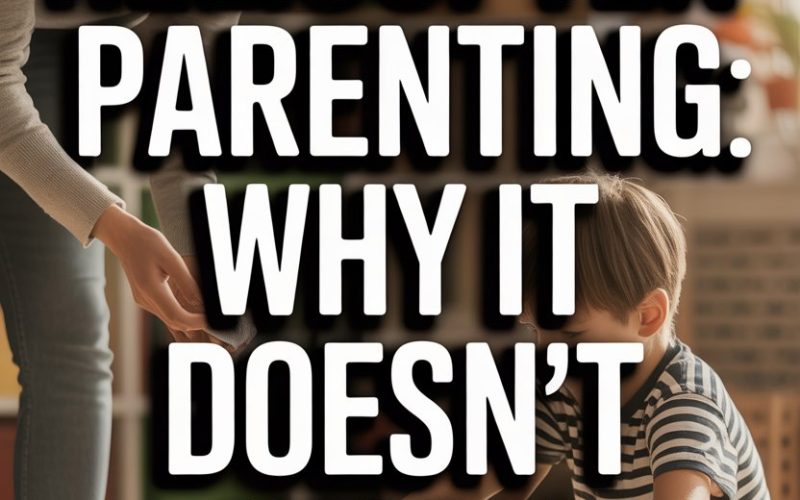Parents, grab your metaphorical seat belts—because we’re about to talk about what really happens when you hover.
Helicopter parenting: the loving, anxious, slightly sweaty art of circling your child’s every move as though they’re a NASA rover on Mars.
The intentions are golden, the execution…well, sometimes it leaves a little to be desired.
Let’s get into why this approach doesn’t bring the shiny, resilient, well-adjusted outcomes you’re hoping for—and what you might try instead.
What Is Helicopter Parenting Anyway
If you’ve ever watched your child’s soccer game from the sideline, clutching a protein bar and whispering, “Go left! No, your other left!”—congratulations, you may have hovered.
Helicopter parenting is the style where adults take an ultra-involved, almost omnipresent role in their children’s lives.
Some say it involves swooping in to solve every problem, from forgotten lunchboxes to social snafus and beyond. Others just call it “Tuesday.”
It’s driven by love and a genuine desire for kids to succeed. But the consequences? Not always what you’d hope.
The Science Isn’t Siding With Helicopters
Research has been pretty clear: while kids need support, constant oversight isn’t the ticket to happiness or success.
One study from the University of Mary Washington found that college students with helicopter parents reported higher rates of depression and less satisfaction with life.
The kids aren’t alright—and it’s not because you didn’t sign them up for Mandarin and ukulele lessons by age six.
Children of helicopter parents often struggle with anxiety, poor coping skills, and a lack of confidence.
Hovering can create a world where every small bump feels like a disaster, because they’ve never had the chance to trip, fall, and dust themselves off.
Why Hovering Feels So Tempting
Modern parenting is a pressure cooker. Social media feeds are crammed with photos of genius toddlers, organic lunchboxes, and achievements galore.
Add in school expectations, safety concerns, and the ever-present fear of “messing it all up,” and it’s practically an Olympic sport not to hover.
The urge to leap in is natural. After all, who wants to watch their child struggle or fail?
Yet, research from Stanford’s Julie Lythcott-Haims suggests that when we remove all obstacles, kids lose the opportunity to develop grit.
And grit, it turns out, is more useful than a trophy shelf full of “participation” awards.
Kids Need to Skin Their Knees (Figuratively, Please)
Learning comes from experience. It’s messy, often awkward, and sometimes involves actual mud.
When children get to make mistakes—and handle the fallout—they build real-world skills that can’t be taught from the driver’s seat (or the sidelines shouting, “Are you sure you want to do that?”).
A scrape on the knee doesn’t just heal; it teaches about caution, consequence, and sometimes, humility. Same goes for a forgotten maths assignment or that time they wore their shirt inside-out all day.
Psychologists like Dr. Madeline Levine argue that kids who aren’t allowed to struggle wind up needing constant direction from others, well into adulthood.
Suddenly, you’re not just packing their school bag at eight, but still reminding them to fill out tax forms at twenty-eight.
What Kids Miss Out On
When parents hover, children can miss three essential life lessons:
- How to solve problems on their own.
- How to tolerate discomfort or failure.
- How to trust themselves.
Without these, it’s tough to develop independence and resilience. In fact, a 2019 study linked helicopter parenting to poor decision-making and low self-esteem—even in young adults.
If every conflict, missing trainer, or playground spat is handled by an adult, kids never get the chance to flex their own problem-solving muscles.
And those are muscles they’ll need long after you’ve stopped checking their reading logs.
Signs You Might Be Hovering (Without Realising It)
You’re not alone if you’ve found yourself emailing your child’s teacher about a seating arrangement. Or, perhaps, you’re the parent who triple-checks the group project for “typos” (you know, just to help).
Some classic clues:
- Doing your child’s chores or projects because it’s easier or faster.
- Intervening in every peer disagreement, even minor ones.
- Solving day-to-day problems like forgotten gear, snacks, or notes.
- Over-scheduling every minute of their day, leaving little space for free play or “boredom.”
If this list gives you a slight sense of déjà vu, deep breaths. The good news? Shifting gears doesn’t require a personality transplant—just a nudge in a new direction.
How to Step Back Without Falling Off the Map
Easing up doesn’t mean you care less. It means you trust your child (and yourself) enough to give them room to grow.
Here’s how you can start, even if you’re juggling deadlines and dinner prep at the same time:
- Try the Pause: Next time your child faces a hiccup (spilled juice, tricky algebra), resist the urge to leap in. Instead, ask, “What do you think would help here?” You might be surprised by their ideas (or at least amused).
- Encourage Small Risks: Let them try something challenging on their own, even if it’s just ordering at the café or walking to school with a friend. Little risks build big confidence.
- Let Natural Consequences Happen: Forgot their lunch? They’ll survive (and probably won’t forget tomorrow). Experiencing the result is a stronger teacher than any parental pep talk.
- Create Space for Boredom: Free time isn’t wasted time. That “I’m bored!” refrain? It’s often the prelude to creativity, problem-solving, or finally tidying their sock drawer. Miracles happen.
When Should Parents Step In
Not every situation is safe for a hands-off approach. Danger, serious bullying, or situations that truly exceed your child’s maturity level still require adult intervention.
Think of your job as the safety net, not the trampoline.
As psychologist Lisa Damour says, the trick is knowing the difference between a learning moment and a genuine crisis.
If your child is truly struggling—emotionally or physically—step in with support, not judgment.
What If You Just…Can’t Help Yourself
It’s hard to undo years of muscle memory. If you find yourself itching to intervene, try shifting your energy to behind-the-scenes support.
Maybe you let your child pack their own school lunch, but you stock the fridge with healthy options. Or you set a consistent bedtime, but let them pick the pyjamas.
If anxiety is fueling your hovering, it’s worth checking in with yourself (or a professional) about ways to manage it.
Children model their emotional responses on yours; showing calm in the face of uncertainty goes further than any lecture on resilience.
Spotlight on Different Ages
Every stage has its own temptations.
- For little ones, it might mean resisting the urge to correct every wobbly block tower or mispronounced word.
- With teens, the stakes feel bigger: curfews, friendships, exams. But micromanaging every social event or school assignment sends the message, “I don’t trust you.” Not exactly the confidence boost most adolescents are after.
The goal is to shift from manager to consultant—available for advice, but not dictating every move.
But What About Safety
Every parent’s worst nightmare is their child in harm’s way. Reasonable boundaries are still vital—seatbelts, internet filters, and walking home before dark haven’t gone out of fashion.
Yet, according to Lenore Skenazy, founder of Free-Range Kids, the world isn’t scarier than it was before—just better documented. Finding a sensible balance between freedom and safety is the sweet spot.
The Perks of Letting Go
Here’s what happens when you relax your grip, even just a smidge:
- Kids learn what they’re capable of (spoiler: often a lot more than you think).
- Stress at home goes down, as everyone feels less pressure to be perfect.
- Relationships improve. When your child thinks you’re in their corner, not controlling their every move, they’re more likely to confide in you.
And yes, you might have more time for yourself. Imagine a world where you can finish a cuppa without being asked where the yellow jumper is—living the dream.
A Fresh Start, One Small Step at a Time
No parent gets it right all the time. If you’ve hovered in the past, that’s not a moral failing—it’s proof of how much you care. The trick is nudging the controls back to your child.
Tonight, when your child faces a challenge, try biting your tongue and waiting an extra beat. Watch what happens.
Maybe they’ll struggle. Maybe they’ll surprise you. Either way, you’re both learning.
One day, those wings you helped grow will be strong enough to fly without you circling overhead. And isn’t that the whole point?
When Less Is More in Parenting
Kids won’t remember how often you checked their spelling, but they’ll remember how they felt about themselves in your company.
When you switch from controller to coach, you give them the space to become who they’re meant to be—and you just might discover a calmer, happier you in the process.
The sky’s still the limit. There’s just no need to circle it nonstop.





